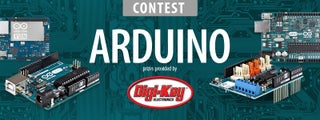Introduction: Candle Making Machine (Arduino)
After holidays, there are tons of burned out candles. Reuse them to make new candles, is a time-consuming job and you're limited to candle forms. Using forms to make candles is not the only way, dipping is another (old, traditional) way to make candles, but doing this by hand, is a boring work. That technique inspired me to make an automatic Arduino powered candle machine. The candle wax is melted by a... candle (tea light). Let's start!
Step 1: Materials
Here is a list of the materials needed for the machine.
Machine
- tea lights (local store)
- wooden (wine) box (app. 32 x 27.5 x 8.5 cm / 12.5 x 10.9 x 3.3 inch)
- some lumber
- screws and bolts:
6 wood screws, length: 20 mm (20 inch, 8 inch)
4 bolts with nuts, ø M8, length: 180 mm (3.1 inch, 7 inch)
- 2 tin cans
Electronics
- Arduino
- passive buzzer (optional)
- servo
- some electric wires
- breadboard (or soldering iron)
Candles
- burned out candles (or candle wax)
- spool candle wicks
Step 2: Build the Stove
My first idea was to use an electric heat element, but that was dangerous to use and i like to keep it simple. During dinner, i saw a tea light dish warmer and i got an idea. I could use a tealight to melt the wax! In that way, wax is used to melt wax.
The stove consists of 4 bolts and nuts. If the wood of the box is too thin you can add a wooden plank inside, see picture.
- Measure the diameter of the biggest can (= D).
- Place the marks on your box or wooden plank (see picture).
- Fix the plank into the box (with wood glue)
- Drill the holes
- Place the bolts into the holes and assemble it with the nuts
For extra stability, a 'plate' (perforated bottom of the biggest can) is added. Cut the the biggest can at 5 cm / 2 inch from the top and perforate it (with a big nail, drill,...). Place it on the 4 bolts.
Step 3: Supports
Make the construction using wood glue. For the instructions/dimensions, see pictures.
TIP: for the hole in the horizontal plank, use a chamfer tool. Make the edge of the hole smooth for guiding the rope.
Step 4: The Servo and Lever
The servo
Take a plank (length: min 5 cm / 2 inch) and drill two holes in the front for the servo. Take another plank (the length doesn't matters) and drill two holes in the side for the servo. Attach the planks to the servo with four screws. Glue and screw the servo to the machine (see picture).
The arm
Saw a drop looking arm. Fix a clothes peg on the arm. Make sure the clothes peg is above the hole, add a wooden block, if needed. Use thumb tacks to attach the servo.
Step 5: Circuit
The circuit is easy. You can solder it, or use a breadboard (like i did). See the first picture.I used rubber bands to attach the wires to the plank. Drill a hole in wooden box and place the circuit (Arduino) under the box. Drill another hole for the usb / power cable. (Fritzing file: see file attached)
Optional: the buzzer
This is used to warn you when the candle is ready (after a preset amount of cycles) .
Attachments
Step 6: Setting Up the Software
Upload the sketch to your Arduino. Disconnect the Arduino. Place the (empty) can on the stove and make sure the arm hit the plank when the servo is at 0 degree. Attach a candle wick to the (servo) arm, make sure it just does not touch the bottom of the can. Power on the Arduino. Check the movement before working with the hot wax: the wick must go up and down. In the upper position the end of the wick comes outside of the can. If not you can adjust by changing parameters in the Arduino sketch. See picture.
Attachments
Step 7: First Candle
The first candle, is the hardest one.
Lower the can using the four screws (make sure the tea light has enough oxygen) to get more heat from the candle. This makes the wax melt more easily. Place a tea light under the stove, fill the can with candle wax. Once it is liquid, higher the plate to lower the temperature of the wax. After the first dip, make sure the wick is straight (if necessary you can stretch it once by hand).
Common problems:
The candle does not thicken. Try one of these:
- Higher the build plate (if possible) to decrease wax temperature.
- Increase the movement speed to avoid melting of the solidified wax on the wick
- Adjust interval time between two cycles
The candle shape is thinner at the bottom.
- Stir the wax to make its temperature more uniform. Position the candle out of the center of the can.
- Increase the movement speed to avoid melting of the solidified wax on the wick

Runner Up in the
Arduino Contest 2016

Participated in the
First Time Authors Contest 2016

Participated in the
Epilog Contest 8









